Employee Retention: How Management Reduces Turnover Rate
VerifiedAdded on 2022/08/20
|6
|1368
|17
Report
AI Summary
This report investigates employee retention, focusing on how better management of employment relations can reduce employee turnover rates. It begins with a research question and then presents a literature review that explores the impact of employee relations on turnover. The review examines various factors, including perceived supervisor support, organizational commitment, leadership styles, open communication, corporate social responsibility, internal marketing, and human resource practices. Key research articles by Kalidass & Bahron (2015), Wakabi (2016), Barry & Wilkinson (2016), Kim, Song, & Lee (2016), and Haider et al. (2015) are discussed to support the arguments. The report highlights the importance of employee satisfaction, engagement, and the role of leaders in fostering a positive work environment to retain key employees and gain a sustainable competitive advantage. The study also emphasizes the significance of internal marketing, CSR activities, and human resource practices, such as compensation, culture, and training and development, in influencing employee commitment and reducing turnover intentions. The references cited provide a comprehensive overview of the research in this field.
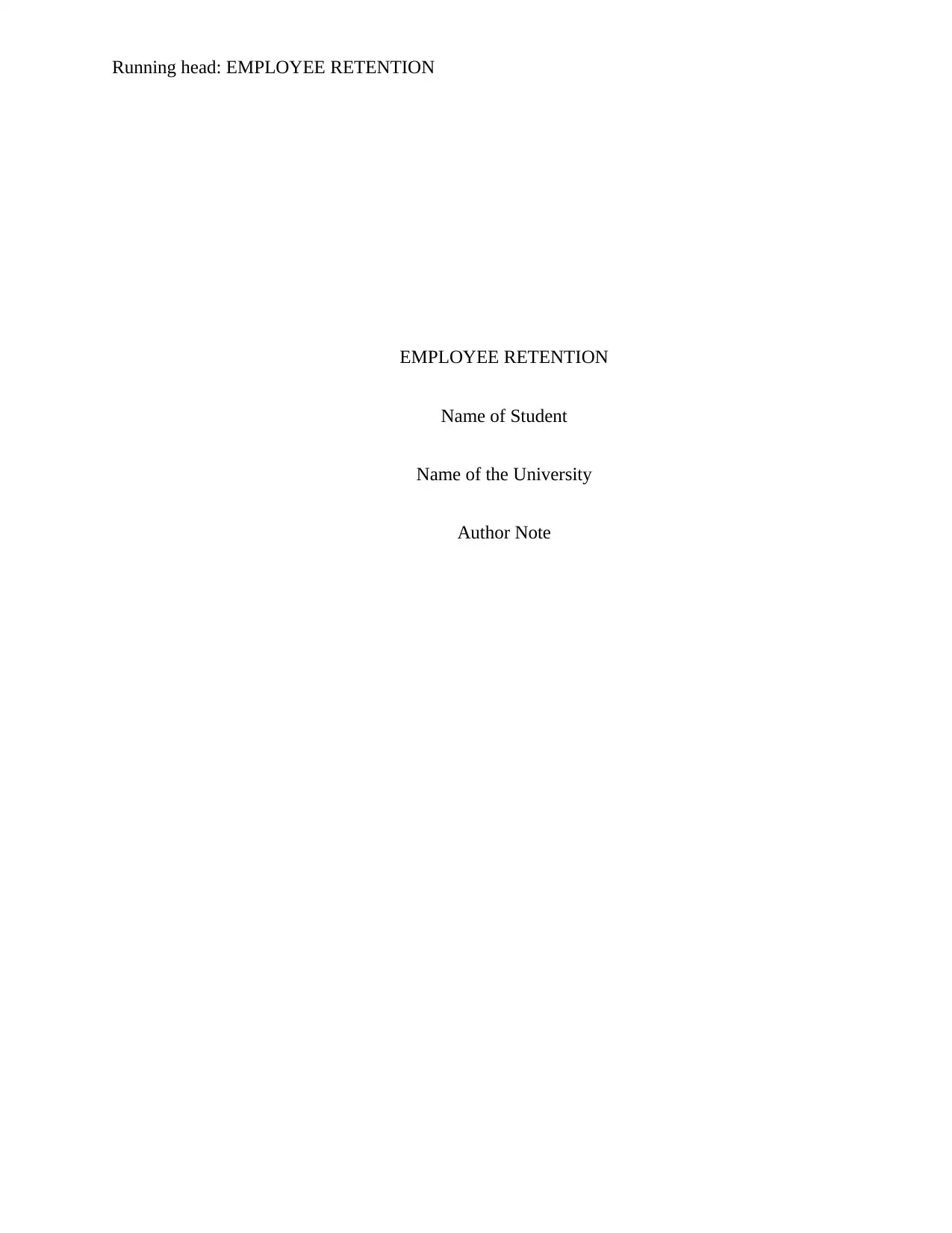
Running head: EMPLOYEE RETENTION
EMPLOYEE RETENTION
Name of Student
Name of the University
Author Note
EMPLOYEE RETENTION
Name of Student
Name of the University
Author Note
Paraphrase This Document
Need a fresh take? Get an instant paraphrase of this document with our AI Paraphraser
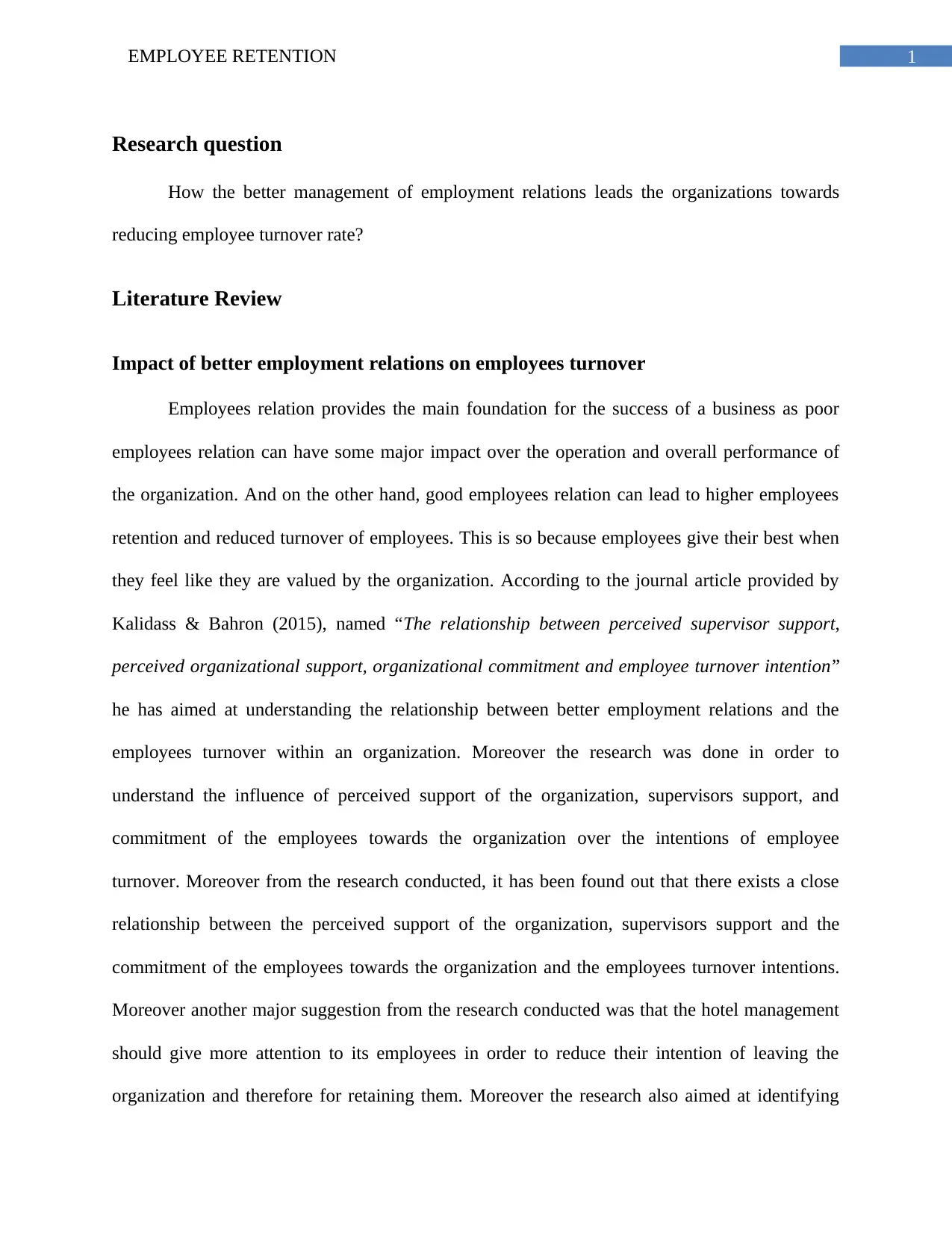
1EMPLOYEE RETENTION
Research question
How the better management of employment relations leads the organizations towards
reducing employee turnover rate?
Literature Review
Impact of better employment relations on employees turnover
Employees relation provides the main foundation for the success of a business as poor
employees relation can have some major impact over the operation and overall performance of
the organization. And on the other hand, good employees relation can lead to higher employees
retention and reduced turnover of employees. This is so because employees give their best when
they feel like they are valued by the organization. According to the journal article provided by
Kalidass & Bahron (2015), named “The relationship between perceived supervisor support,
perceived organizational support, organizational commitment and employee turnover intention”
he has aimed at understanding the relationship between better employment relations and the
employees turnover within an organization. Moreover the research was done in order to
understand the influence of perceived support of the organization, supervisors support, and
commitment of the employees towards the organization over the intentions of employee
turnover. Moreover from the research conducted, it has been found out that there exists a close
relationship between the perceived support of the organization, supervisors support and the
commitment of the employees towards the organization and the employees turnover intentions.
Moreover another major suggestion from the research conducted was that the hotel management
should give more attention to its employees in order to reduce their intention of leaving the
organization and therefore for retaining them. Moreover the research also aimed at identifying
Research question
How the better management of employment relations leads the organizations towards
reducing employee turnover rate?
Literature Review
Impact of better employment relations on employees turnover
Employees relation provides the main foundation for the success of a business as poor
employees relation can have some major impact over the operation and overall performance of
the organization. And on the other hand, good employees relation can lead to higher employees
retention and reduced turnover of employees. This is so because employees give their best when
they feel like they are valued by the organization. According to the journal article provided by
Kalidass & Bahron (2015), named “The relationship between perceived supervisor support,
perceived organizational support, organizational commitment and employee turnover intention”
he has aimed at understanding the relationship between better employment relations and the
employees turnover within an organization. Moreover the research was done in order to
understand the influence of perceived support of the organization, supervisors support, and
commitment of the employees towards the organization over the intentions of employee
turnover. Moreover from the research conducted, it has been found out that there exists a close
relationship between the perceived support of the organization, supervisors support and the
commitment of the employees towards the organization and the employees turnover intentions.
Moreover another major suggestion from the research conducted was that the hotel management
should give more attention to its employees in order to reduce their intention of leaving the
organization and therefore for retaining them. Moreover the research also aimed at identifying
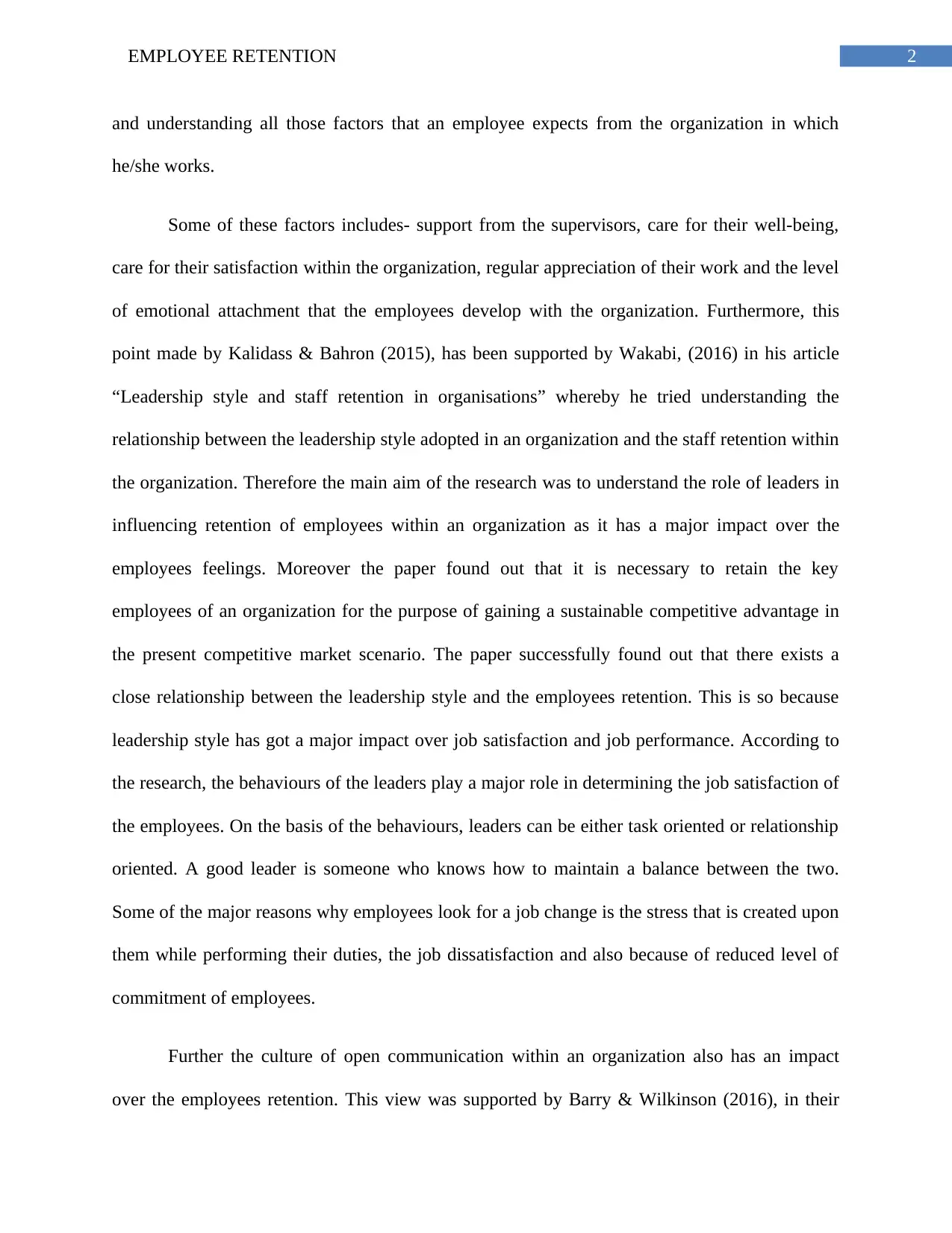
2EMPLOYEE RETENTION
and understanding all those factors that an employee expects from the organization in which
he/she works.
Some of these factors includes- support from the supervisors, care for their well-being,
care for their satisfaction within the organization, regular appreciation of their work and the level
of emotional attachment that the employees develop with the organization. Furthermore, this
point made by Kalidass & Bahron (2015), has been supported by Wakabi, (2016) in his article
“Leadership style and staff retention in organisations” whereby he tried understanding the
relationship between the leadership style adopted in an organization and the staff retention within
the organization. Therefore the main aim of the research was to understand the role of leaders in
influencing retention of employees within an organization as it has a major impact over the
employees feelings. Moreover the paper found out that it is necessary to retain the key
employees of an organization for the purpose of gaining a sustainable competitive advantage in
the present competitive market scenario. The paper successfully found out that there exists a
close relationship between the leadership style and the employees retention. This is so because
leadership style has got a major impact over job satisfaction and job performance. According to
the research, the behaviours of the leaders play a major role in determining the job satisfaction of
the employees. On the basis of the behaviours, leaders can be either task oriented or relationship
oriented. A good leader is someone who knows how to maintain a balance between the two.
Some of the major reasons why employees look for a job change is the stress that is created upon
them while performing their duties, the job dissatisfaction and also because of reduced level of
commitment of employees.
Further the culture of open communication within an organization also has an impact
over the employees retention. This view was supported by Barry & Wilkinson (2016), in their
and understanding all those factors that an employee expects from the organization in which
he/she works.
Some of these factors includes- support from the supervisors, care for their well-being,
care for their satisfaction within the organization, regular appreciation of their work and the level
of emotional attachment that the employees develop with the organization. Furthermore, this
point made by Kalidass & Bahron (2015), has been supported by Wakabi, (2016) in his article
“Leadership style and staff retention in organisations” whereby he tried understanding the
relationship between the leadership style adopted in an organization and the staff retention within
the organization. Therefore the main aim of the research was to understand the role of leaders in
influencing retention of employees within an organization as it has a major impact over the
employees feelings. Moreover the paper found out that it is necessary to retain the key
employees of an organization for the purpose of gaining a sustainable competitive advantage in
the present competitive market scenario. The paper successfully found out that there exists a
close relationship between the leadership style and the employees retention. This is so because
leadership style has got a major impact over job satisfaction and job performance. According to
the research, the behaviours of the leaders play a major role in determining the job satisfaction of
the employees. On the basis of the behaviours, leaders can be either task oriented or relationship
oriented. A good leader is someone who knows how to maintain a balance between the two.
Some of the major reasons why employees look for a job change is the stress that is created upon
them while performing their duties, the job dissatisfaction and also because of reduced level of
commitment of employees.
Further the culture of open communication within an organization also has an impact
over the employees retention. This view was supported by Barry & Wilkinson (2016), in their
⊘ This is a preview!⊘
Do you want full access?
Subscribe today to unlock all pages.

Trusted by 1+ million students worldwide
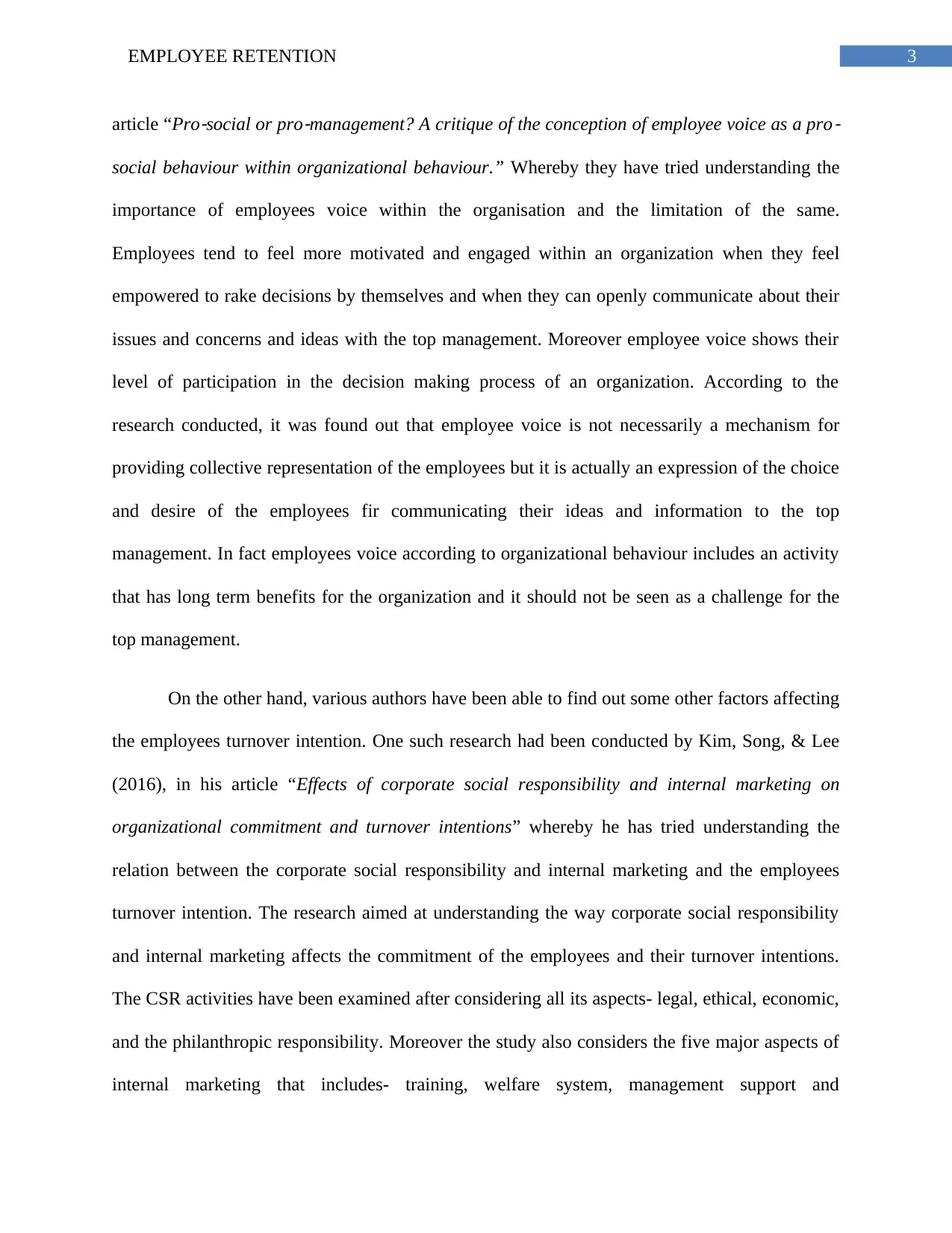
3EMPLOYEE RETENTION
article “Pro
‐social or pro
‐management? A critique of the conception of employee voice as a pro
‐
social behaviour within organizational behaviour.” Whereby they have tried understanding the
importance of employees voice within the organisation and the limitation of the same.
Employees tend to feel more motivated and engaged within an organization when they feel
empowered to rake decisions by themselves and when they can openly communicate about their
issues and concerns and ideas with the top management. Moreover employee voice shows their
level of participation in the decision making process of an organization. According to the
research conducted, it was found out that employee voice is not necessarily a mechanism for
providing collective representation of the employees but it is actually an expression of the choice
and desire of the employees fir communicating their ideas and information to the top
management. In fact employees voice according to organizational behaviour includes an activity
that has long term benefits for the organization and it should not be seen as a challenge for the
top management.
On the other hand, various authors have been able to find out some other factors affecting
the employees turnover intention. One such research had been conducted by Kim, Song, & Lee
(2016), in his article “Effects of corporate social responsibility and internal marketing on
organizational commitment and turnover intentions” whereby he has tried understanding the
relation between the corporate social responsibility and internal marketing and the employees
turnover intention. The research aimed at understanding the way corporate social responsibility
and internal marketing affects the commitment of the employees and their turnover intentions.
The CSR activities have been examined after considering all its aspects- legal, ethical, economic,
and the philanthropic responsibility. Moreover the study also considers the five major aspects of
internal marketing that includes- training, welfare system, management support and
article “Pro
‐social or pro
‐management? A critique of the conception of employee voice as a pro
‐
social behaviour within organizational behaviour.” Whereby they have tried understanding the
importance of employees voice within the organisation and the limitation of the same.
Employees tend to feel more motivated and engaged within an organization when they feel
empowered to rake decisions by themselves and when they can openly communicate about their
issues and concerns and ideas with the top management. Moreover employee voice shows their
level of participation in the decision making process of an organization. According to the
research conducted, it was found out that employee voice is not necessarily a mechanism for
providing collective representation of the employees but it is actually an expression of the choice
and desire of the employees fir communicating their ideas and information to the top
management. In fact employees voice according to organizational behaviour includes an activity
that has long term benefits for the organization and it should not be seen as a challenge for the
top management.
On the other hand, various authors have been able to find out some other factors affecting
the employees turnover intention. One such research had been conducted by Kim, Song, & Lee
(2016), in his article “Effects of corporate social responsibility and internal marketing on
organizational commitment and turnover intentions” whereby he has tried understanding the
relation between the corporate social responsibility and internal marketing and the employees
turnover intention. The research aimed at understanding the way corporate social responsibility
and internal marketing affects the commitment of the employees and their turnover intentions.
The CSR activities have been examined after considering all its aspects- legal, ethical, economic,
and the philanthropic responsibility. Moreover the study also considers the five major aspects of
internal marketing that includes- training, welfare system, management support and
Paraphrase This Document
Need a fresh take? Get an instant paraphrase of this document with our AI Paraphraser
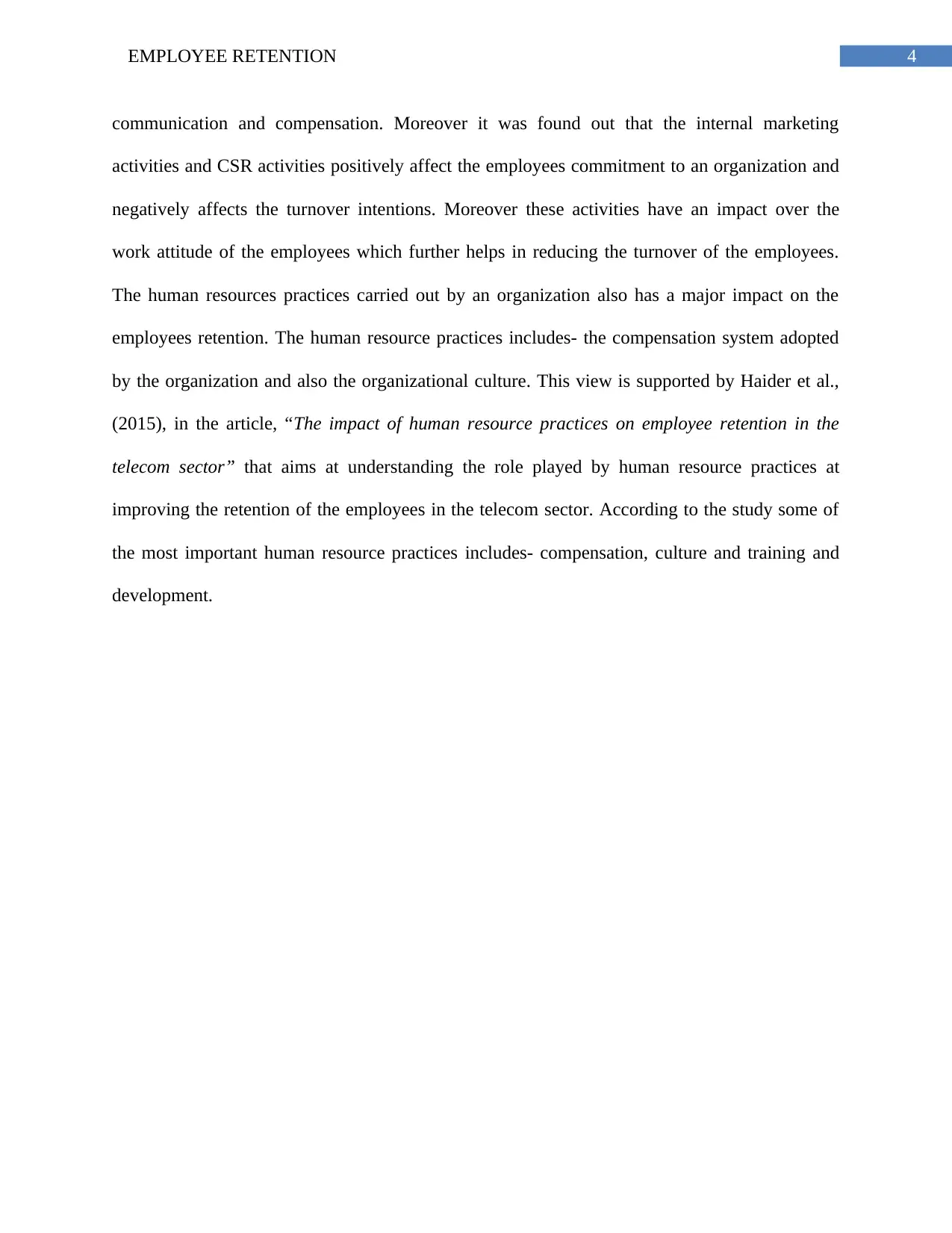
4EMPLOYEE RETENTION
communication and compensation. Moreover it was found out that the internal marketing
activities and CSR activities positively affect the employees commitment to an organization and
negatively affects the turnover intentions. Moreover these activities have an impact over the
work attitude of the employees which further helps in reducing the turnover of the employees.
The human resources practices carried out by an organization also has a major impact on the
employees retention. The human resource practices includes- the compensation system adopted
by the organization and also the organizational culture. This view is supported by Haider et al.,
(2015), in the article, “The impact of human resource practices on employee retention in the
telecom sector” that aims at understanding the role played by human resource practices at
improving the retention of the employees in the telecom sector. According to the study some of
the most important human resource practices includes- compensation, culture and training and
development.
communication and compensation. Moreover it was found out that the internal marketing
activities and CSR activities positively affect the employees commitment to an organization and
negatively affects the turnover intentions. Moreover these activities have an impact over the
work attitude of the employees which further helps in reducing the turnover of the employees.
The human resources practices carried out by an organization also has a major impact on the
employees retention. The human resource practices includes- the compensation system adopted
by the organization and also the organizational culture. This view is supported by Haider et al.,
(2015), in the article, “The impact of human resource practices on employee retention in the
telecom sector” that aims at understanding the role played by human resource practices at
improving the retention of the employees in the telecom sector. According to the study some of
the most important human resource practices includes- compensation, culture and training and
development.
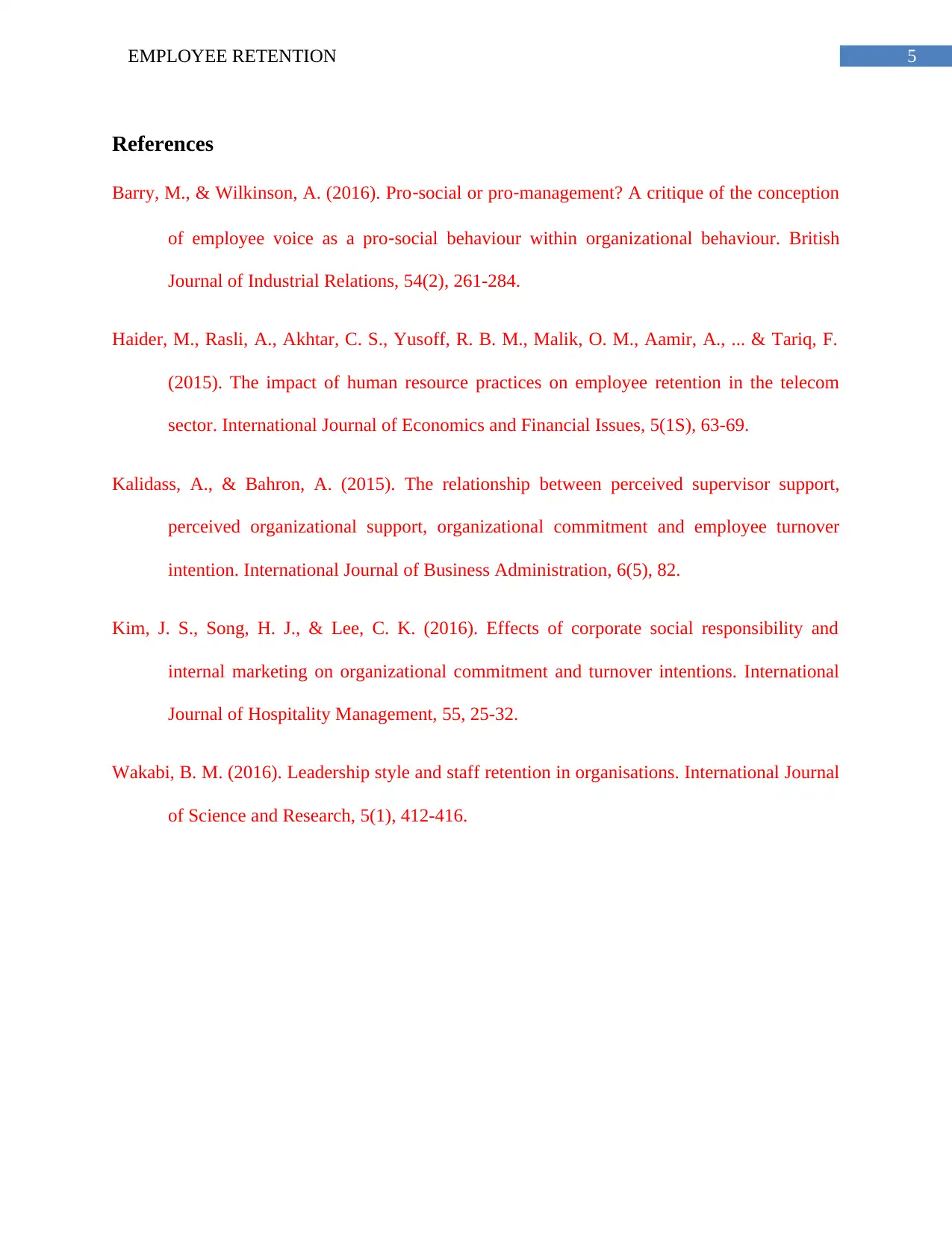
5EMPLOYEE RETENTION
References
Barry, M., & Wilkinson, A. (2016). Pro‐social or pro‐management? A critique of the conception
of employee voice as a pro‐social behaviour within organizational behaviour. British
Journal of Industrial Relations, 54(2), 261-284.
Haider, M., Rasli, A., Akhtar, C. S., Yusoff, R. B. M., Malik, O. M., Aamir, A., ... & Tariq, F.
(2015). The impact of human resource practices on employee retention in the telecom
sector. International Journal of Economics and Financial Issues, 5(1S), 63-69.
Kalidass, A., & Bahron, A. (2015). The relationship between perceived supervisor support,
perceived organizational support, organizational commitment and employee turnover
intention. International Journal of Business Administration, 6(5), 82.
Kim, J. S., Song, H. J., & Lee, C. K. (2016). Effects of corporate social responsibility and
internal marketing on organizational commitment and turnover intentions. International
Journal of Hospitality Management, 55, 25-32.
Wakabi, B. M. (2016). Leadership style and staff retention in organisations. International Journal
of Science and Research, 5(1), 412-416.
References
Barry, M., & Wilkinson, A. (2016). Pro‐social or pro‐management? A critique of the conception
of employee voice as a pro‐social behaviour within organizational behaviour. British
Journal of Industrial Relations, 54(2), 261-284.
Haider, M., Rasli, A., Akhtar, C. S., Yusoff, R. B. M., Malik, O. M., Aamir, A., ... & Tariq, F.
(2015). The impact of human resource practices on employee retention in the telecom
sector. International Journal of Economics and Financial Issues, 5(1S), 63-69.
Kalidass, A., & Bahron, A. (2015). The relationship between perceived supervisor support,
perceived organizational support, organizational commitment and employee turnover
intention. International Journal of Business Administration, 6(5), 82.
Kim, J. S., Song, H. J., & Lee, C. K. (2016). Effects of corporate social responsibility and
internal marketing on organizational commitment and turnover intentions. International
Journal of Hospitality Management, 55, 25-32.
Wakabi, B. M. (2016). Leadership style and staff retention in organisations. International Journal
of Science and Research, 5(1), 412-416.
⊘ This is a preview!⊘
Do you want full access?
Subscribe today to unlock all pages.

Trusted by 1+ million students worldwide
1 out of 6
Related Documents
Your All-in-One AI-Powered Toolkit for Academic Success.
+13062052269
info@desklib.com
Available 24*7 on WhatsApp / Email
![[object Object]](/_next/static/media/star-bottom.7253800d.svg)
Unlock your academic potential
Copyright © 2020–2025 A2Z Services. All Rights Reserved. Developed and managed by ZUCOL.





